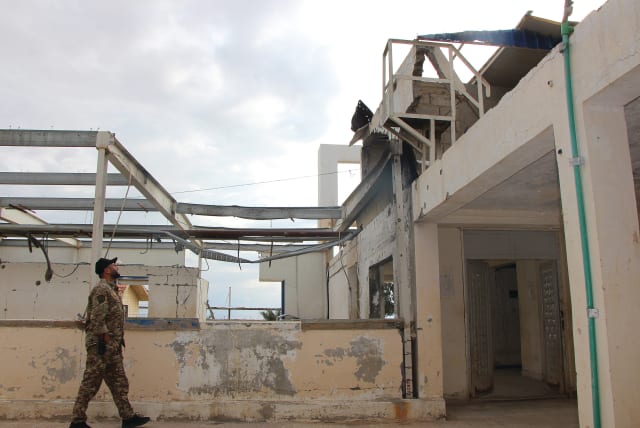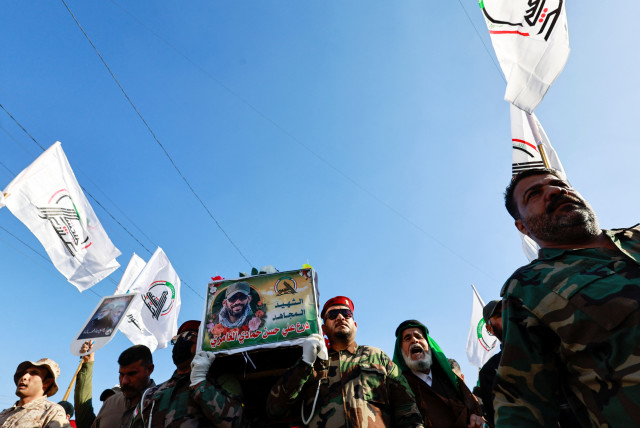US shows no apparent strategy to counter Kataib Hezbollah's attacks

The attack on Rumeilan is significant from a number of points of view.
On April 21, Iran-supported Shia militia fighters launched five rockets at a US landing strip near the oil town of Rumeilan, in northeast Syria. The launch site was outside Zummar, close to the Iraq-Syria border on the Iraqi side. No one was injured. A Telegram group associated with the Kataib Hezbollah organization, the most powerful of the Iraqi Shia militias, claimed responsibility for the attack. A later statement by another channel affiliated with the organization denied that the claim of responsibility reflected the official stance of the movement. The US rapidly responded, destroying the truck with a mounted rocket launcher with an airstrike.
The attack on Rumeilan is significant from a number of points of view.
First and most obviously, it brings to an end a nearly three-month period in which the Iranians and their militia proxies had ceased direct attacks on American targets. Until the Rumeilan strike, the most recent attack had taken place at the al-Omar oil field on February 5. On that occasion, six fighters from the US-aligned, Kurdish-dominated Syrian Democratic Forces (SDF) were killed when an Iranian suicide drone targeted a special forces training facility maintained by the organization. The al-Omar attack itself was immediately preceded by an Iraqi Shia militia attack on the Tower 22 base maintained by the US on the Jordan-Syria border on January 28, in which three US service personnel were killed.
Secondly, the attack is notable in that it came a day after Iraqi Prime Minister Mohammed Shia al-Sudani completed a visit to the United States. In remarks following his meeting with the Iraqi prime minister, President Joe Biden described the “partnership” between the United States and Iraq as “critical.” He praised Sudani for his focus on “strengthening Iraq’s economy and energy independence.”
It is worth noting that Emma Tsurkov, sister of the abducted Russian-Israeli researcher and Princeton PhD candidate Elizabeth Tsurkov, had sought an audience with the Iraqi leader while in the US, to ask for his help in securing her sister’s release. He, however, did not find time to meet with her. Nevertheless, her request was a logical one. Her sister is being held by the Kataib Hezbollah organization. This, as noted above, is the group that just launched five rockets at the US landing strip in Rumeilan.
Kataib Hezbollah is also, in its political iteration, part of the parliamentary bloc on whose support Sudani’s coalition rests.
The Huquq (Rights) list established by the movement controls six seats in the 329-member Iraqi parliament. It is part of the Coordination Framework, an alliance of pro-Iran parties that was responsible for the formation of the current Iraqi government and the appointment of Sudani as prime minister. (Incidentally, the Huquq list takes its legislative duties seriously. It played, for example, a prominent role in the recent passage in the Iraqi parliament of legislation banning homosexuality.)
IN ITS military (as opposed to terrorist) incarnation, meanwhile, Kataib Hezbollah forms an integral part of Prime Minister Sudani’s security forces. The Shia militias assembled in the framework of the Popular Mobilization Units (PMU) to face the onslaught of Islamic State in the summer of 2014 were subsequently kept mobilized as a permanent element of Iraq’s armed forces.
Kataib Hezbollah forms an integral element of the PMU. The latter was allocated $2.8 billion in the Iraqi state budget of 2023, according to a report by Lebanese-Iraqi researcher Hussein Abdul Hussein at the Foundation for the Defense Of Democracies (FDD). The PMU intends to use these funds to double their ranks from 122,000 to 238,000 fighters in the period ahead.
So let’s get this straight: The prime minister of a pro-Iranian government which was formed by a parliamentary coalition dominated by IRGC-aligned militias in their guise as political parties was just given the red carpet treatment in Washington.
Among the IRGC-aligned militias in question is a group engaged in an active and murderous insurgency against US forces and their allies – namely, Kataib Hezbollah. This same organization is engaged in the kidnapping of citizens of Western countries. It has been holding a student of a top US university hostage since last March. Sudani made no indication that any of this is set to change as a result of his visit, and indeed at least in his public statement, the US president made no reference to, nor even hinted at, this reality.
It is worth noting that the sector which President Biden did choose to single out for praise was that of energy. Chinese firms are now overseeing two-thirds of Iraq’s oil output. It is not clear if this is what the president was referring to when he praised Sudani’s efforts in securing his country’s “energy independence.”
It cannot be stated with certainty whether Kataib Hezbollah’s decision to recommence its attacks on US facilities was timed to coincide with the completion of Sudani’s US visit.
If it wasn’t, the coincidence is notable. Nor should it be thought that the US remains a passive recipient of the movement’s aggression. As the swift response to the rocket fire on the 21st shows, the US military is determined and effective in its responses to the Iraqi Shia militias’ insurgency against it. Yet this determination does not appear to form part of a more general strategy as to how to help its allies and roll back its enemies in the region.
Speaking with the 23-year-old commander
Visiting, in mid-March, the site of the Shia militia attack on the SDF at the al-Omar oilfield, I spoke to the 23-year-old commander of the special forces training course in which the five SDF fighters had been taking part when they were killed.
He noted that the facility that was struck (a sleeping quarters) was located three or four km. away from the nearest positions of the US-led coalition. “It wasn’t an accident,” he told me. “We’ve been targeted 10 times before, and the drones have very specific coordinates.’
THE STRIKE at al-Omar was one element of an ongoing low-level insurgency that the Iraqi Shia militias are conducting in eastern Syria and Iraq. In Deir al-Zur, I learned of regular incursions across the Euphrates by Iran-linked forces and of efforts to agitate among the Arab tribes east of the river by the IRGC and its allies.
All form part of an effort to make life difficult for the US, without raising the temperature to such a degree that the US will identify a major challenge and seek to match it. In this way, the tendency to target US allies rather than US forces themselves makes sense. The notion is that if things reach a certain pitch of discomfort, the US, in any case, unsure of its mission in these areas, will withdraw.
As of now, the US appears happy to accept this curious arrangement according to which certain elements of the Iraqi coalition come to Washington and conduct high-level state visits, while other components wage insurgent war against the US and its allies, and kidnap Western citizens.
“We’ve promised the dead we’ll continue their march,” the young SDF commander at the al-Omar base told me.
It’s not clear who’ll be marching beside them, though, or for how long.
Jerusalem Post Store
`; document.getElementById("linkPremium").innerHTML = cont; var divWithLink = document.getElementById("premium-link"); if (divWithLink !== null && divWithLink !== 'undefined') { divWithLink.style.border = "solid 1px #cb0f3e"; divWithLink.style.textAlign = "center"; divWithLink.style.marginBottom = "15px"; divWithLink.style.marginTop = "15px"; divWithLink.style.width = "100%"; divWithLink.style.backgroundColor = "#122952"; divWithLink.style.color = "#ffffff"; divWithLink.style.lineHeight = "1.5"; } } (function (v, i) { });

